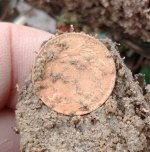I'm new to metal detecting and have an ace 250 and a garret pinpointer. I have done about 20 hours and all I have found is clad and 2 wheats. I was wondering if its common to find silver in that amount of time. Is it possible that my detector isn't doing deep enough. I have the sensitivity set between 3-4. Everything I find is about 4 inches and above. I'm trying not to get discouraged but its hard when you don't find anything cool. One more question, I was in the back yard of a house that was built in 1914 and about 9 inches deep I found something metal that is around 12 inches by 12 inches, Is it worth digging up or should i leave it. Thanks.
Upvote
0



 It just depends on where you hunt. Only undisturbed turf seems to be stratified by age (the older, the generally deeper it is). But other locations don't have this: furroughed fields, old-town urban demolition sites, beaches after storm erosion, cow-pasture type terra firma, etc....
It just depends on where you hunt. Only undisturbed turf seems to be stratified by age (the older, the generally deeper it is). But other locations don't have this: furroughed fields, old-town urban demolition sites, beaches after storm erosion, cow-pasture type terra firma, etc....


